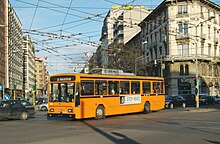
A dual-mode bus is a bus that can run independently on power from two different sources, typically electricity from overhead lines like a trolleybus or from batteries like a hybrid bus, alternated with conventional fossil fuel. In contrast to other hybrid buses, dual-mode buses can run forever exclusively on their electric power source (wires). Several of the examples listed below involve the use of dual-mode buses to travel through a tunnel on electric overhead power.

A bi-articulated bus or double-articulated bus and sometimes train-bus, tram-bus, trackless tram or double bendy bus is a type of high-capacity articulated bus with an extra axle and a second articulation joint, as well as extended length. Bi-articulated buses tend to be employed in high-frequency core routes or bus rapid transit schemes rather than in conventional bus routes.

The current tram system in Rome, Italy, is a leftover from what once was the largest tram system in Italy. With its fragmented structure, it does not currently function as a backbone of the city's public transport. The system is owned and operated by Azienda Tranvie e Autobus del Comune di Roma.
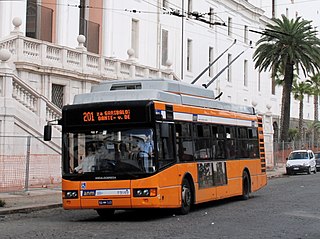
Trolleybuses in Naples provide a portion of the public transport service in the city and comune of Naples, in the region of Campania, southern Italy. From 1964 to 2015, two independent trolleybus systems were in operation, both publicly owned, but only that of Azienda Napoletana Mobilità (ANM) remains in operation. The ANM system opened in 1940, whereas the smaller trolleybus network of Compagnia Trasporti Pubblici di Napoli (CTP) opened in 1964.
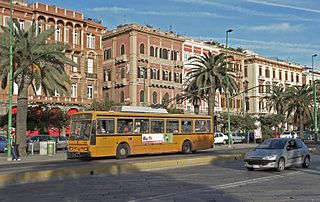
The Cagliari trolleybus system forms part of the public transport network of the city and comune of Cagliari, in the region of Sardinia, Italy.

The Rome trolleybus system forms part of the public transport network of the city and comune of Rome, Italy. In operation since 2005, the current system comprises three routes.
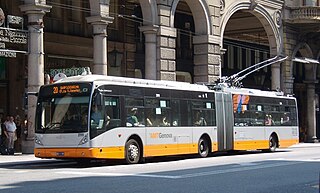
The Genoa trolleybus system forms part of the public transport network of the city and comune of Genoa, in the region of Liguria, northern Italy. In operation since 1997, the system currently comprises only one route. Between 2008 and 2012, two routes were being operated.

The Parma trolleybus system forms part of the public transport network of the city and comune of Parma, in the region of Emilia-Romagna, northern Italy. In operation since 1953, the system presently comprises four urban routes.
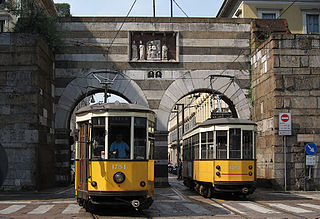
The Milan tramway network is part of the public transport network of Milan, Italy, operated by Azienda Trasporti Milanesi (ATM).
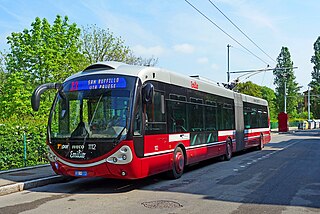
The Bologna trolleybus system is part of the public transport network of the city and comune of Bologna, in the region of Emilia-Romagna, northern Italy. While being in operation since 1991, the current system comprises five urban routes: 13, 14, 15, 32 and 33. Additional routes are presently under construction.
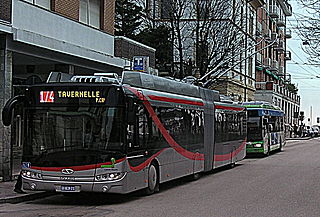
The Ancona trolleybus system forms part of the public transport network of the city and comune of Ancona, in the Marche region, central Italy. In operation since 1949, the system presently comprises only one urban route.

The Chieti trolleybus system forms part of the public transport network of the city and comune of Chieti, in the region of Abruzzo, central Italy. In operation since 2009, the system comprises one urban route.

The Modena trolleybus system forms part of the public transport network of the city and comune of Modena, in the region of Emilia-Romagna, northern Italy.

The La Spezia trolleybus system forms part of the public transport network of the city and comune of La Spezia, in the region of Liguria, northwest Italy.

The Rimini trolleybus system forms part of the public transport network of the Province of Rimini, in the region of Emilia-Romagna, Italy.

The Lyon trolleybus system is part of the public transport network of the city and commune of Lyon, France. Opened in 1935, it combines with the Lyon Metro, the Lyon tramway network and Lyon's urban motorbus network to form an integrated system.

The Cantono Frigerio system was an Italian electric power supply for trackless trolleybuses with two wires about 20 inches (50 cm) apart being contacted by a four-wheeled collector on a single trolley pole. In English publications it was often described as Filovia system although the Italian term filovia means literally wire way, i.e. a trolleybus line or a trolleybus system.
The Vaslui trolleybus system is a one route trolleybus network in the Romanian city of Vaslui.
Trasporto Passeggeri Emilia-Romagna is a public company overseeing public transportation in the Metropolitan City of Bologna, in the province of Ferrara and in parts of the provinces of Modena and Ravenna, Italy.



